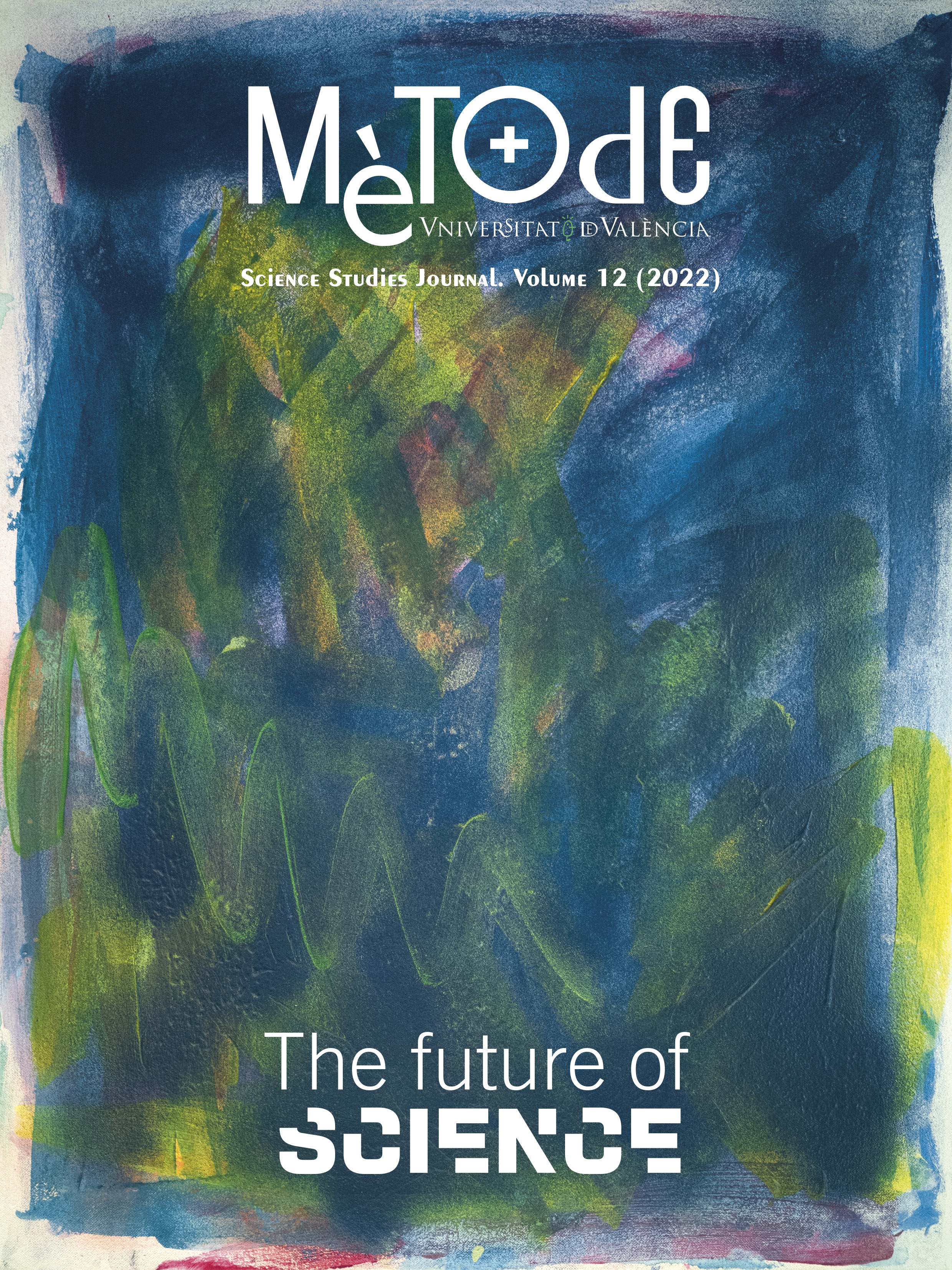The science of transhumanism: Are we nearly there?
DOI:
https://doi.org/10.7203/metode.12.20710Keywords:
augmentation, Brain-Machine Interface, CRISPR, cyborg, genome editing Abstract
Abstract
Transhumanism looks to utilise science and technology to move humans beyond the limitations of their natural form. Recent scientific advances have, for the first time, presented plausible genetic interventions for the directed evolution of humans. In separate developments, electromechanical innovations, including miniaturisation of components and improvements in bio-compatible materials, have seen breakthroughs in brain-machine interfaces (BMIs) that potentiate a cybernetic dimension, in which mechanical devices would be under the direct control of the mind. This article offers insight into the most important of these recent advances, with particular emphasis on genome editing and therapeutic uses of BMIs in which the same technology might be employed for enhancement.
 Downloads
Downloads
 References
References
Begley, S. (2017, August 10). Birth of CRISPR’d pigs advances hopes for turning swine into organ donors. STAT. https://www.statnews.com/2017/08/10/crispr-pigs-organ-transplant
Brooks, R. (2017). The seven deadly sins of AI predictions. MIT Technology Review, 120(6), 79–86. https://www.technologyreview.com/2017/10/06/241837/the-seven-deadly-sins-of-ai-predictions
Collinger, J. L., Wodlinger, B., Downey, J. E., Wang, W., Tyler-Kabara, E. C., Weber, D. J., McMorland, A. J. C., Velliste, M., Boninger, M. L., & Schwartz, A. B. (2013). High-performance neuroprosthetic control by an individual with tetraplegia. The Lancet, 381(9866), 557–564. https://doi.org/10.1016/S0140-6736(12)61816-9
Corbyn, Z. (2019, September 22). Are brain implants the future of thinking? The Guardian. https://www.theguardian.com/science/2019/sep/22/brain-computer-interface-implants-neuralink-braingate-elon-musk
Flesher, S. N., Collinger, J. L., Foldes, S. T., Weiss, J. M., Downey, J. E., Tyler-Kabara, E. C., Bensmaia, S. J., Schwartz, A. B., Boninger, M. L., & Gaunt, R. A. (2016). Intracortical microstimulation of human somatosensory cortex. Science Translational Medicine, 8(361), 361ra141. https://doi.org/10.1126/scitranslmed.aaf8083
Gaj, T., Gersbach, C. A., & Barbas III, C. F. (2013). ZFN, TALEN, and CRISPR/Cas-based methods for genome engineering. Trends in Biotechnology, 31(7), 397–405. https://doi.org/10.1016/j.tibtech.2013.04.004
Giger, J. C., Piçarra, N., Alves‐Oliveira, P., Oliveira, R., & Arriaga, P. (2019). Humanization of robots: Is it really such a good idea? Human Behavior and Emerging Technologies, 1(2), 111–123. https://doi.org/10.1002/hbe2.147
Lebedev, M. A., Opris, I., & Casanova, M. F. (2018). Augmentation of brain function: Facts, fiction and controversy. Frontiers in Systems Neuroscience, 12, 45. https://doi.org/10.3389/fnsys.2018.00045
Platt, R. J. (2019). CRISPR tool enables precise genome editing. Nature, 576, 48–49. https://doi.org/10.1038/d41586-019-03392-9
Polikov, V. S., Tresco, P. A., & Reichert, W. M. (2005). Response of brain tissue to chronically implanted neural electrodes. Journal of Neuroscience Methods, 148(1), 1–18. https://doi.org/10.1016/j.jneumeth.2005.08.015
Rauti, R., Musto, M., Bosi, S., Prato, M. & Ballerini, L. (2019). Properties and behavior of carbon nanomaterials when interfacing neuronal cells: How far have we come? Carbon, 143, 430–446. https://doi.org/10.1016/j.carbon.2018.11.026
Regalado, A. (2019, December 30). He Jiankui faces three years in prison for CRISPR babies. MIT Technology Review. https://www.technologyreview.com/2019/12/30/131061/he-jiankui-sentenced-to-three-years-in-prison-for-crispr-babies
Roelfsema, R., Denys, D., & Klink, P. C. (2018). Mind reading and writing: The future of neurotechnology. Trends in Cognitive Sciences, 22(7), 598–610. https://doi.org/10.1016/j.tics.2018.04.001
Salas, M. A., Bashford, L., Kellis, S., Jafari, M., Jo, H. C., Kramer, D., Shanfield, K., Pejsa, K., Lee, B., Liu, C. Y., & Andersen, R. A. (2018). Proprioceptive and cutaneous sensations in humans elicited by intracortical microstimulation. eLife, 7, e32904. https://doi.org/10.7554/eLife.32904
Shook, J. R., & Giordano, J. (2016). Neuroethics beyond normal: Performance enablement and self-transformative technologies. Cambridge Quarterly of Healthcare Ethics, 25(1), 121–140. https://doi.org/10.1017/S0963180115000377
Tirosh-Samuelson, H. (2018). In pursuit of perfection: The misguided transhumanist vision. Theology and Science, 16(2), 200–222. https://doi.org/10.1080/14746700.2018.1463659
Waldert, S. (2016). Invasive vs. non-invasive neuronal signals for brain-machine interfaces: Will one prevail? Frontiers in Neuroscience, 10, 295. https://doi.org/10.3389/fnins.2016.00295
Wang, T., Wei, J. J., Sabatini, D. M., & Lander, E. S. (2014). Genetic screens in human cells using the CRISPR-Cas9 system. Science, 343(6166), 80–84. https://doi.org/10.1126/science.1246981
Yazdi, P. (2020, September 22). 13 effects of transcranial direct current stimulation (tDCS). SelfHacked. https://selfhacked.com/blog/tdcs-benefits
Downloads
Additional Files
Published
How to Cite
-
Abstract1495
-
(Español)6
-
PDF921
Issue
Section
License
![]()
All the documents in the OJS platform are open access and property of their respective authors.
Authors publishing in the journal agree to the following terms:
- Authors keep the rights and guarantee Metode Science Studies Journal the right to be the first publication of the document, licensed under a Creative Commons Attribution-NonCommercial-NoDerivatives 4.0 International License that allows others to share the work with an acknowledgement of authorship and publication in the journal.
- Authors are allowed and encouraged to spread their work through electronic means using personal or institutional websites (institutional open archives, personal websites or professional and academic networks profiles) once the text has been published.





